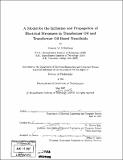| dc.contributor.advisor | Markus Zahn. | en_US |
| dc.contributor.author | O'Sullivan, Francis M. (Francis Martin), 1980- | en_US |
| dc.contributor.other | Massachusetts Institute of Technology. Dept. of Electrical Engineering and Computer Science. | en_US |
| dc.date.accessioned | 2008-11-10T19:56:04Z | |
| dc.date.available | 2008-11-10T19:56:04Z | |
| dc.date.copyright | 2007 | en_US |
| dc.date.issued | 2007 | en_US |
| dc.identifier.uri | http://dspace.mit.edu/handle/1721.1/40504 | en_US |
| dc.identifier.uri | http://hdl.handle.net/1721.1/40504 | |
| dc.description | Thesis (Ph. D.)--Massachusetts Institute of Technology, Dept. of Electrical Engineering and Computer Science, 2007. | en_US |
| dc.description | Includes bibliographical references (p. 305-309). | en_US |
| dc.description.abstract | The widespread use of dielectric liquids for high voltage insulation and power apparatus cooling is due to their greater electrical breakdown strength and thermal conductivity than gaseous insulators, while their ability to conform to complex geometries and self-heal means that they are often of more practical use than solid insulators. Transformer oil is a particularly important dielectric liquid. The issues surrounding its electrical breakdown have been the subject of extensive research. Much of this work has focused on the formation of electrical streamers. These are low-density conductive structures that form in regions of oil that are over-stressed by electric fields on the order of 1 x 108 (V/m) or greater. Once a streamer forms it tends to elongate, growing from the point of initiation towards a grounding point. The extent of a streamer's development depends upon the nature of the electrical excitation which caused it. Sustained over-excitation can result in a streamer bridging the oil gap between its point of origin and ground. When this happens an arc will form and electrical breakdown will occur. Streamers can form due to both positive and negative excitations. Positive streamers are considered more dangerous as they form at lower electric field levels and propagate with higher velocities than negative streamers. Historically, the modeling of streamer development has proved to be a very difficult task. Much of this difficulty relates to the identification of the relevant electrodynamic processes involved. In the first section of this thesis a comprehensive analysis of the charge generation mechanisms that could play a role in streamer development is presented. | en_US |
| dc.description.abstract | (cont.) The extent of the electrodynamics associated with Fowler-Nordheim charge injection, electric field dependent ionic dissociation (the Onsager Effect) and electric field dependent molecular ionization in electrically stressed transformer oil are assessed and it is shown that molecular ionization, which results in the development of an electric field wave, is the primary mechanism responsible for streamer development. A complete three carrier liquid-phase molecular ionization based streamer model is developed and solved for a positive needle electrode excitation using the COMSOL Multiphysics finite element simulation suite. The modification of the liquid-phase molecular ionization model to account for the two-phase nature of streamer development is described and the performance of both the liquid-phase and gas/liquid two-phase models are compared with experimental results reported in the literature. The second section of this thesis focuses on the insulating characteristics of transformer oil-based nanofluids. These nanofluids, which can be manufactured from a variety of materials, have been shown to possess some unique insulating characteristics. Earlier experimental work has shown that oil-based nanofluids manufactured using conductive nanoparticles have substantially higher positive voltage breakdown levels than that of pure oil. A comprehensive electrodynamic analysis of the processes which take place in electrically stressed transformer oil-based nanofluids is presented, which illustrates how conductive nanoparticles act as electron scavengers in electrically stressed transformer oil-based nanofluids. As part of this analysis, a completely general expression for the charging dynamics of a nanoparticle in transformer oil is developed. | en_US |
| dc.description.abstract | (cont.) The solutions for the charging dynamics of a range of nanoparticle materials are presented and the implications these charging dynamics have on the development of streamers in oil-based nanofluid is explained. To confirm the validity of the electrodynamic analysis, the electric field dependent molecular ionization model for streamers in pure oil is modified for use with transformer oil-based nanofluids. This model is solved for nanofluids manufactured using conductive and insulating particles and the results that are presented confirm the paradoxical fact that nanofluids manufactured from conductive nanoparticles have superior positive electrical breakdown performance to that of pure oil. The thesis concludes by exploring the possibility of developing simplified streamer models for both transformer oil and transformer oil-based nanofluids, which are computationally efficient and can be solved quickly meaning that they can be used as practical design tools. | en_US |
| dc.description.statementofresponsibility | by Francis M. O'Sullivan. | en_US |
| dc.format.extent | 309 p. | en_US |
| dc.language.iso | eng | en_US |
| dc.publisher | Massachusetts Institute of Technology | en_US |
| dc.rights | M.I.T. theses are protected by
copyright. They may be viewed from this source for any purpose, but
reproduction or distribution in any format is prohibited without written
permission. See provided URL for inquiries about permission. | en_US |
| dc.rights.uri | http://dspace.mit.edu/handle/1721.1/40504 | en_US |
| dc.rights.uri | http://dspace.mit.edu/handle/1721.1/7582 | en_US |
| dc.subject | Electrical Engineering and Computer Science. | en_US |
| dc.title | A model for the initiation and propagation of electrical streamers in transformer oil and transformer oil based nanofluids | en_US |
| dc.type | Thesis | en_US |
| dc.description.degree | Ph.D. | en_US |
| dc.contributor.department | Massachusetts Institute of Technology. Department of Electrical Engineering and Computer Science | |
| dc.identifier.oclc | 191825413 | en_US |

